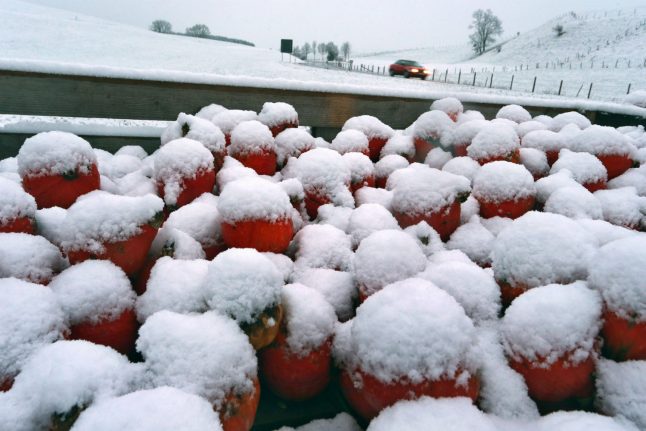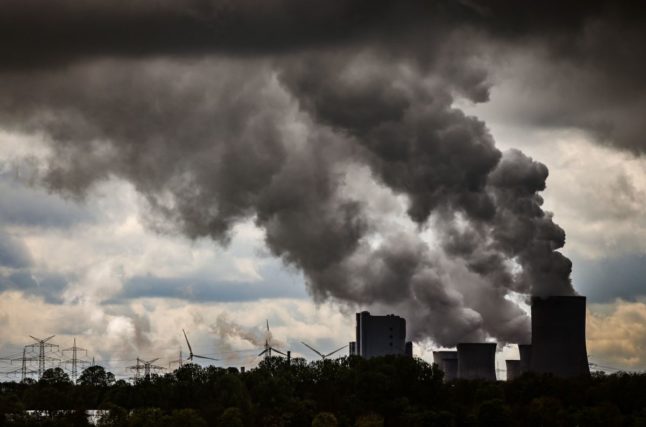“The weather remains dingy and uncomfortable in many places this week,” Rainer Buchhop, MeteoGroup weather expert, told t-online.de.
On Thursday, stormy weather is expected throughout much of south Germany. In the morning winds of up to 75 kilometres per hour struck the southern areas of Oberallgäu, Garmisch-Partenkirchen und Berchtesgadener, leading the German Weather Service (DWD) to issue a storm warning level 2 (orange).
READ ALSO: Warning over icy roads and storms as Germany gets first taste of winter
In many places – such as Oberstdorf in the Bavarian Alps, where the Mercury dropped to -10C on Wednesday night – there will be icy surfaces, said Buchhop.
In the west and southwest, cloudy weather is expected throughout the day. Around the Danube river, temperatures are slated to stay around 4C. In Berlin and Bremen the Mercury shows 8C, and in Düsseldorf 7C.
Frost is expected to completely cover the rest of Bavaria and Baden-Württemberg on Thursday, according to DWD.
Frosty weather is also expected in parts of the western state of Hesse, particularly in Fulda.
Schnee in den Hochlagen des Südostens (#Schneehöhen im #Schwarzwald und im #Bayerischen Wald heute Morgen um 15 cm, auf der #Zugspitze 90 cm. Dazu Nebel in den roten Bereichen des Sat-Bildes (vor allem in Bayern, teils aber auch in Sachsen, Thüringen, Hessen, RLP und NRW. /V pic.twitter.com/DzJnjlrHzu
— DWD (@DWD_presse) November 14, 2019
This map shows snow and fog around the country, with red representing fog density.
A cloudy and wet Friday
Friday will be particularly uncomfortable in Germany’s southern Alps, with strong wind striking at higher altitudes.
But gusts and hurricanes can also occur in the valleys as the day progresses.
Throughout the country it will become cloudy and wet, with especially heavy rain falling in the south and along the coasts.
In the east, temperatures are expected to climb to the double digits: in Görlitz up to 13C, and in southeast Passau up to 10C.
But temperatures will drop significantly in western Germany: In Emmerich in North Rhine-Westphalia the Mercury shows 5C, and in Stuttgart 6C.
Sunny Saturday and chillier Sunday
Saturday morning is slated to start with pouring rain in the north, though the downpour will slowly simmer down as the day goes on.
In the calmer south, dense clouds will cover the sky, but the weather should remain mostly dry.
Central Germany will have the most pleasant weather, with the sun coming out for most of the day.
Still, temperatures will stay cold throughout the country. In Munich the Mercury show 4C, in northern Schleswig 6C. Dresden can expect 9C, while in western Neuss they will be 7C.

St. Englmar in the Bavarian Forest on Wednesday. Photo: DPA
On Sunday the weather remains unpleasant, said Buchhop, with “snowy rain” expected around the country.
However, it is not yet possible to say exactly in which regions this will be the case.
“There are too many lows on the way at the moment,” said the meteorologist. In Lusatia in the east the thermometer shows 12C, and in Hamburg 8C. In western Germany Trier and Freiburg are expecting chilly temperatures of around 5C.
However the weather will calm down a bit the following week. Although it will remain cloudy in the west, there won’t be as much rainfall as the previous days, with showers only hitting the coasts, according to DWD.
In Frankfurt an der Oder the thermometer shows 11C, and in Hamburg 8C. In Stuttgart and the Ruhr area 6C is expected.




 Please whitelist us to continue reading.
Please whitelist us to continue reading.
Member comments